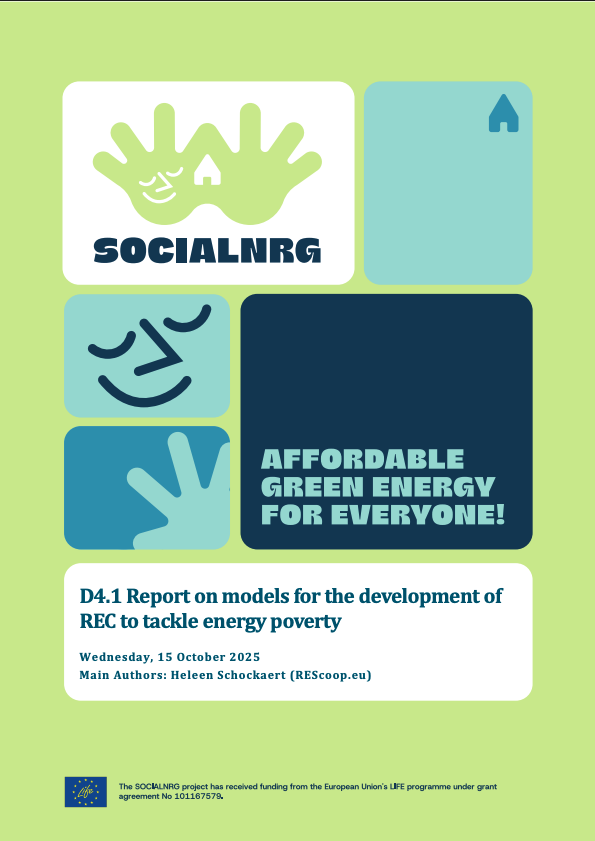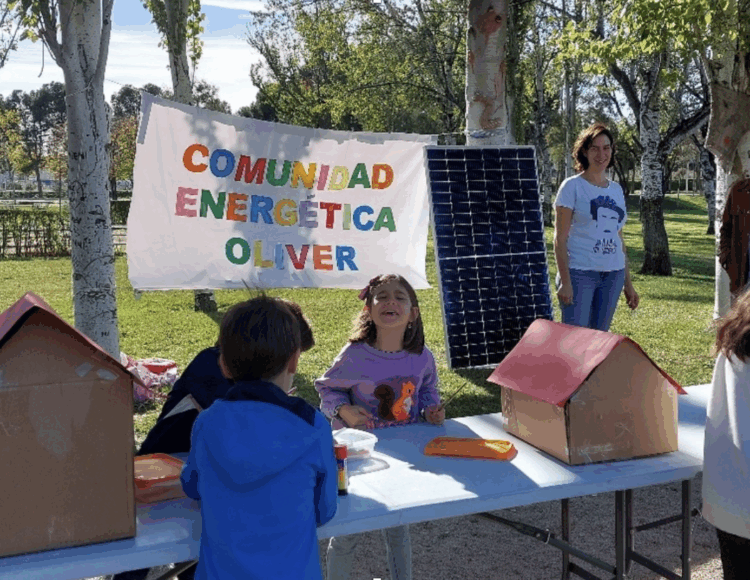From producing renewable power that vulnerable households can use to helping neighbours cut bills, energy community initiatives are showing that energy can be fair, democratic, and local. They already deliver tangible social, environmental, and economic benefits lowering energy costs, strengthening local ties, and empowering residents to take control of their energy future.
The paradox is that their potential remains largely untapped. Complex rules, heavy paperwork, and unclear regulations continue to make setting up a community daunting. While many are eager to include lower-income households, today’s energy markets still fail to value social impact. In practice, striving for inclusiveness can even weaken a community’s business case, leaving vulnerable households on the sidelines despite the long-term benefits of savings, empowerment, and energy security.
These insights come from a new mapping report by Heleen Schockaert of REScoop, developed under the EU-funded SOCIALNRG project coordinated by Housing Europe. Drawing on over 60 initiatives across Europe, the research explores what makes energy communities successful and where they struggle, offering valuable lessons for policymakers, housing providers, and citizens working to make the energy transition truly just.
In Belgium, Klimaan, an energy cooperative and SOCIALNRG partner, leveraged citizen investments to fund solar panels on 197 social housing units managed by Woonland, a social housing provider in Flanders which is also delivering one of the three pilots in the project. This initiative prioritises social impact over profit, offering tenants stable, affordable energy prices shielded from market fluctuations. Klimaan is also renovating 71 vacant homes for social housing and studying the feasibility of a district heating network in a social housing neighbourhood. Beyond energy, it promotes sustainable mobility by offering electric car-sharing and bike services to help residents reach essential services, and partners with the local organisaton SAAMO on projects that provide energy-efficient appliances for rent to low-income tenants.
In the Netherlands, Wattnu is installing solar PV systems on buildings managed by three social housing associations by 2025, with all benefits flowing directly to tenants. In the UK, Repowering London, after several successful community power projects on social housing estates, recently collaborated with the Greater London Authority and Future Climate to develop a toolkit for retrofitting apartment blocks — a critical gap often overlooked compared to single-family homes.
Nevertheless, challenges such as underinvestment in social housing, legal barriers, and a lack of technical and social expertise still hinder the broad roll-out of such initiatives. Matching the growing citizen motivation with stronger policy frameworks, targeted financial support, and capacity-building measures will be key to ensuring that social housing and energy communities together can drive Europe’s just and democratic energy transition.
What struck Heleen most from the research is the sheer dedication of these communities. Citizens are willing to invest time, money, and energy, even when the system does not make it easy. Their motivation is clear they want a fairer, more democratic energy transition that does not leave anyone behind.
Looking ahead, the upcoming EU Citizen Energy Package could make a difference by providing guidance, clearer rules, and support for citizen-led energy projects. Heleen stresses that ambition is not lacking; communities are ready to act. What they need now are the right conditions, such as supportive policies, capacity building, and technical assistance, to scale their impact and ensure that all households, including the most vulnerable, can benefit.

Read our interview with Heleen below and download the “Report on models for the development of REC to tackle energy poverty” from the section at the bottom.
Heleen, if you had to explain it shortly, what’s the state of energy communities in Europe?
Energy communities in Europe are gaining visibility and recognition as key actors in the clean energy transition. And for the past years, the energy community movement has been creating considerable economic, social and environmental value for citizens and their local communities. Yet, their potential remains largely untapped due to complex administrative barriers, unclear regulations and insufficient support. Joining or setting up an energy community remains still more of a promise than a reality for many citizens across the EU. With the energy transition reaching a critical point and (geo)political tensions intensifying, it is more important than ever to empower citizens to take an active role and strengthen democratic decision making —fostering behavioural change, building trust in renewables, and reinforcing social acceptance of the broader climate and energy transition.
What’s the major struggle people on the ground are facing?
In today’s energy landscape, establishing and managing an energy community can be a challenging endeavour. Citizens, who often volunteer their time for these initiatives, must navigate complex regulatory and legislative processes which largely remain tailored to traditional market players. In the mapping report we mostly focused on what this means with regards to engaging vulnerable households. On the side of the energy community, we see that many of them are struggling to engage vulnerable households because social impact and inclusion largely remain unaccounted for in today’s energy markets. This means that pursuing social goals can ultimately undermine the business case for an energy community and its ability to stand its ground in a competitive environment. In other words: striving for social inclusiveness and equality is currently being penalised by the energy system rather than being encouraged or enabled.
When we then look at what this means for people in vulnerable situations, it’s clear that they are often left behind and find themselves stuck in a particularly disadvantaged position to participate in the energy transition, and, by extension, in energy communities. While the benefits are numerous —such as social cohesion, financial gains, empowerment, and long-term energy security—immediate financial and other concerns, as well as potential conflict with receiving welfare benefits, may overshadow these long-term advantages, leaving vulnerable households structurally disincentivised to engage. Ensuring that energy communities become a real, achievable opportunity for households experiencing vulnerability is crucial to structurally improve their circumstances, and ultimately ensuring a truly just and democratic energy transition.
Are those who have managed to set them up proud to be part of an energy community, are they convinced that was the right choice?
I’m sure that people involved in an energy community sometimes second-guess some of the choices they’ve made—it’s definitely not always easy. There are so many administrative hurdles to navigate, licenses to secure, and countless other things to handle to get a community up and running. But the fact that so many citizens are willing to dedicate their time and money to making it work, definitely tells you something about the benefits these initiatives can generate in return.
What striked you?
From the SOCIALNRG Open Call it has become clear that those that seek to leverage the community energy model to address energy poverty often face quite some obstacles, as mentioned above already. Yet, given the numerous responses that our Open Call got (over 60 cases are included in the report!), it’s clear that energy communities are really dedicated and motivated to try and go the extra mile, and this despite the lack of supportive legislation and financial instruments and despite the fact that social impact is massively undervalued in the current energy landscape. Their consistent efforts to include vulnerable households in both membership and benefit-sharing underline a commitment to tackling energy poverty and broadening democratic participation. They are demonstrating the willingness and readiness to address these challenges. What they lack is not ambition, but the enabling conditions to scale their impact.
How do you see energy communities developing in the next 5-10 years?
There’s definitely quite some initiatives on the horizon which could boost positive change for energy communities and households in vulnerable situations alike, one being the soon to be released Citizen Energy Package which could create renewed momentum for citizen-led initiatives in the energy transition by setting new targets, providing useful guidance for Member State governments and creating more capacity for citizens from all walks of life to participate in the energy transition. It can’t be overstated how important this is given the current geopolitical context and democratic backlash against climate and energy policies. By creating clear pathways for our shared energy future we can showcase that collaboration, democratic decision-making and social inclusion are stronger drivers for a secure and prosperous Europe than closed borders, relentless competition and excessive deregulation at the expense of environmental, social and climate goals.
If we highlight 2-3 legislative hurdles what would they be?
Since the Fit for 55 revisions of the EU climate and energy legislation, the rights for citizens to become active participants in the energy market has increased. As said above, to create equal opportunities for each and every household and individual it is important to match these achievements with concrete implementation, capacity building and technical and social assistance. Such measures would ensure that energy communities can complement—rather than compete with—existing social protections, making it easier for vulnerable families to participate and benefit from the energy transition.
The SOCIALNRG project has received funding from the European Union’s LIFE programme under grant agreement No 101167579.
